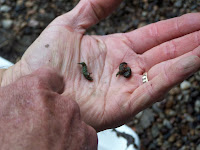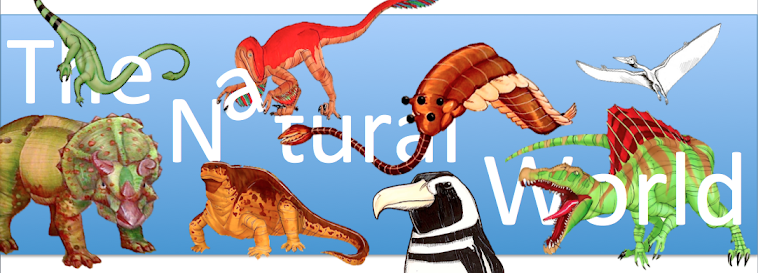Recently, the folks over at the
Best Western Denver Southwest purchased yet another fossil cast for their amazing hotel!* This time, the cast is of a
skull nicknamed "Judith," a specimen that is referred by some
paleontologists to the
dinosaur genus
Ceratops. And, no, I didn't mean to say
Triceratops. Don't feel bad if you haven't heard of
Ceratops montanus: as a matter of fact, I hadn't really heard of it either until several weeks ago, when
Greg Tally informed me that the
Morrison Natural History Museum would soon be receiving a very large box in the mail! Judith is still in the
Cretaceous Room here at the MNHM, where she will stay for at least a few more weeks. I really didn't know much at all about this dinosaur, and was eager to learn more. Unfortunately, there's not much out there, as
Ceratops is based on just a few bones that were discovered in the late 1800s. Despite the lack of material,
Ceratops does have a pretty fascinating history, and is an incredibly important dinosaur; not because of what has been discovered about the fossils themselves, so much as what these fossils resulted in.
 |
| Greg Tally peers through one of the fenestrae (literally means "window" in Latin) in the skull of Judith, the Ceratops montanus skull for the hotel that is temporarily on display at the Morrison Museum. Photo Credit: Greg and Meredith Tally |
When it comes to giving an animal or a group of animals a scientific classification, there are a lot of hoops you have to jump through, and a bunch of rules you have to follow. Sometimes, groups of animals are named after the best known and understood animal in that group. For example,
Stegosaurus is the genus of dinosaur that defined the group of animals called the
stegosaurs, and
Tyrannosaurus is the genus of dinosaur that defined the group of animals called the
tyrannosaurs. Sometimes, it isn't quite as simple. Think about it this way: Las Vegas is easily the most famous city in
Nevada, and I'm sure I'm not the only one who spent a significant portion of their childhood thinking that Las Vegas was the capital of Nevada. However, it is Carson City that holds the official title of capital. Even though Las Vegas receives much more attention than Carson City, the state of Nevada isn't simply going to change where its capital is, and to the best of my knowledge, a change like that never really happens.
Although that comparison was a bit of a stretch and had about as many holes as the skull of
Chasmosaurus, I think you get my point. The same thing goes for scientific names. Although
Triceratops is the best known individual of the dinosaurian group called the
ceratopsians, this group is still called the ceratopsians, as opposed to being called the triceratopsians. That's because it was
Ceratops, and not
Triceratops, that was described by scientists first.
 |
| Ceratops montanus, temporarily on display at the Morrison Natural History Museum. Photo Credit: Greg and Meredith Tally |
The year was 1888, and paleontology in western
North America was still going strong. We've talked about the
Bone Wars between paleontologists
Othniel Charles Marsh and
Edward Drinker Cope before, and we are going to revisit Marsh in this post. To maximize the number of fossils he could describe, Marsh called upon the talents of a large number of fossil collectors, including the always brilliant
Arthur Lakes in
Morrison,
Colorado. Another of these collectors was a man named John Bell Hatcher. Although Hatcher should also be remembered for a large number of his contributions to paleontology, for our purposes here we remember Hatcher as the man who discovered
Ceratops. On a trip to a known dinosaur fossil site near the Judith River in
Montana, Hatcher discovered a number of fossils. One of these fossil discoveries was composed only of a pair of
horn cores.
Doesn't sound like much, does it? Well, truth be told, it wasn't, though it was enough for Marsh to realize that he had something new. If you click
HERE, you can view the two page paper that Marsh published in 1888 that briefly described this new discovery as an animal called "
Ceratops montanus." There are several things of interest that we should take away from this paper, some of which are:
- Marsh originally suspected that this new creature was "nearly allied to Stegosaurus of the Jurassic, but differs especially in having had a pair of large horns on the upper part of the head." Marsh got the location of the horns right, but the close relation to Stegosaurus.....not so much. Given the enormously tiny sampling of bones he had to work with though, it's not a surprise that Marsh compared this new animal to something that he already knew a good deal about. Keep in mind that this is the very first scientific description of a ceratopsian dinosaur, so Marsh just had to go off of what had already been discovered. Which was nothing.
- Marsh notes that the "position and direction" of the horns could be likened to the enormous Meiolania, an extinct turtle from Australia, as well as the lizards in the genus Phrynosomax, the horned lizards. He also notes that amongst the dinosaurs, the "only known example of a similar structure....is the single median horn-core on the nasals of Ceratosaurus," a mid-sized theropod dinosaur from the Late Jurassic Morrison Formation.
- In 1887, the year before this paper was published, geologist Whitman Cross sent Marsh a pair of horn cores about two feet in length and six inches across at their widest point. Discovered right smack dab in the middle of where Denver, Colorado is today, Cross relayed to Marsh that they had been discovered in beds of Cretaceous rock. Marsh, however, decided that these horns must have belonged to some sort of enormous bison, and gave the horns the name "Bison alticornis." Perhaps Marsh was still suffering from the misconception that the 1887 discovery was, indeed, an enormous extinct bison, as these 1887 Denver horn cores are not mentioned in the brief Ceratops paper. It is mentioned, however, that if the horns were discovered "detached," their "resemblance in form and position of the posterior horn-cores to those of some of the ungulate mammals is very striking," and the horns would "naturally be referred to that group." I have no evidence to support my hypothesis, but I wonder whether this comparison to the mammalian ungulates is insurance on the part of Marsh, as perhaps at this point he had recognized the true nature of the 1887 horn cores. This is pure conjecture on my part, and is mostly irrelevant anyways, as in 1889 Marsh recognized the dinosaurian nature of the Denver cores, and referred them to the genus Ceratops. Today, these horn cores are regarded as belonging to Triceratops.
- Marsh mentions that several limb bones, vertebrae, and teeth were also found in the Ceratops horizon, as well as several bits of dermal armor, and states that he believes they also belonged to Ceratops. Whether this is true or not I do not know, but what I do know to be false is Marsh's next sentence, in which he states that the bones "indicate a close affinity with Stegosaurus, which was probably the Jurassic ancestor of Ceratops." The specimen is housed in the Smithsonian today, under the catalogue number USNM 2411. A search through the online records of the Smithosonian shows that 2411 consists only of a partial skull, which seems to be consistent with what I've read in other sources. I'm not sure whether these other skeletal elements mentioned above have found a definitive dinosaurian home, or whether their true owner is uncertain.
- The final paragraph is, in my opinion, inarguably the most important. The paragraph reads as follows: "The remains at present referred to this genus, while resembling Stegosaurus in various important characters, appear to represent a distinct and highly specialized family, that may be called the Ceratopsidae." In this paragraph, Marsh has created the group of dinosaurs that, more colloquially, we refer to as the ceratopsians. Or, more colloquially than that, "those dinosaurs that look like Triceratops with those horns."
Ceratops was discovered in what scientists now call the Judith River Formation. Several other ceratopsians have been discovered in this formation, and due to the small amount and fragmentary nature of the material that was originally described as
Ceratops, most paleontologists consider the dinosaur to be a nomen dubium. Nomen dubium pretty much means that the material is too fragmentary for it to be diagnostic, and can't really be used in the future to determine whether new specimens are the same as the original or not. Whether or not the newly discovered Judith specimen currently on display at the Morrison Museum is, indeed,
Ceratops is still up in the air, as the paper has not been published yet. Almost all of my
Ceratops knowledge is out on the table for all to see, so I am not going to speculate or attempt to draw conclusions about something that I don't really know enough about to have an informed opinion on. Guess we will just have to wait and see! In the meantime, come on by the Morrison Natural History Museum and the Best Western Denver Southwest to see Judith, and much more!
*If you've been living underground amongst worms and fossils for the last few months, you might not have heard of the hotel, so you can check out some incredible pictures of the best Best Western by clicking
HERE and
HERE.
Works Cited:











































